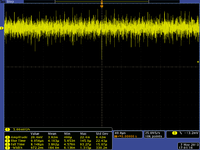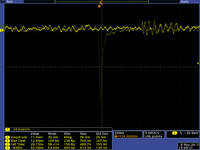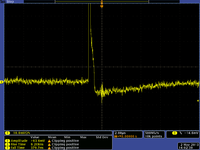Difference between revisions of "R1 S6 SignalSearchLog"
Jump to navigation
Jump to search
| Line 19: | Line 19: | ||
|- | |- | ||
| || || U24 || || Warm Wire: This is a channel that always triggers a fake signal. | | || || U24 || || Warm Wire: This is a channel that always triggers a fake signal. | ||
| + | [[File:U24_1380_WARM.png|200px]] | ||
|- | |- | ||
| || || U38 || || Warm Wire. | | || || U38 || || Warm Wire. | ||
Revision as of 21:05, 9 May 2013
Testing procedure
Things that may cause "noise" that are actually due to your testing setup:
- STB boards not securely attached to chamber. Make sure center screws (ones attaching directly to the chamber, not the nylon stand-offs) are tightened to 14 in. lb's.
- Scope's termination set to 1Mohm. Set the scope to 50ohm termination.
- Lower bandwidth of 1 Ghz scope to 200 Mhz. This attenuates peak height, but also rejects high frequency noise and reduces the noise level from 55-65 mV to ~11-15 mV.
Super Layer 1
STB-1 G1202220
| Layer | Wire | Channel | Date | Comments |
| U1 | This channel presents higher noise level than the other ones, which makes difficult to get a signal with amplitude below 30mV. This behaviour extends to all the first channels of each connector in the board. however, if a high enough trigger level is set in the scope(~40mV), it is always possible to get a signal in these channels. | |||
| U24 | Warm Wire: This is a channel that always triggers a fake signal. | |||
| U38 | Warm Wire. | |||
| U66 | HOT Wire: This is a channel that always triggers a fake signal very often. | |||
| U87 | HOT Wire. | |||
| U93 | HOT Wire. |
The rest of channels not mention here has a similar behaviour between them, with a noise level not greater than ~20mV.
STB-2 G1202266
| Layer | Wire | Channel | Date | comments |
| U38 | Hot wire. | |||
| U40 | Warm wire. | |||
| U51 | Hot wire. | |||
| U65 | Hot wire. |
STB-3 G1202273
| Layer | Wire | Channel | Date | comments |
| U1 | Hot wire. | |||
| U2 | Hot wire. | |||
| U39 | Hot wire. | |||
| U78 | Hot wire. |
STB-4 G1202275
STB-5
| Layer | Wire | Date | comments |
STB-6
| Layer | Wire | Date | comments |
STB-7
| Layer | Wire | Date | comments |
Super Layer 2
STB-1
| Layer | Wire | Date | comments |
STB-2
| Layer | Wire | Date | comments |
STB-3
| Layer | Wire | Date | comments |
STB-4
| Layer | Wire | Date | comments |
STB-5
| Layer | Wire | Date | comments |
STB-6
| Layer | Wire | Date | comments |
STB-7
| Layer | Wire | Date | comments |


